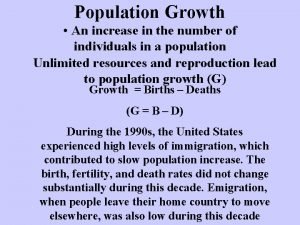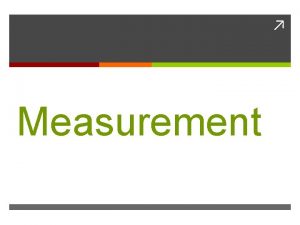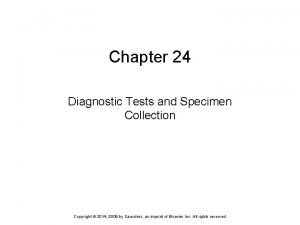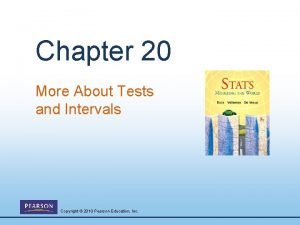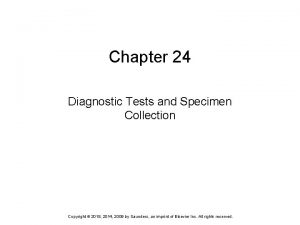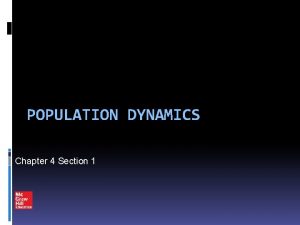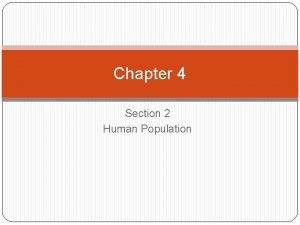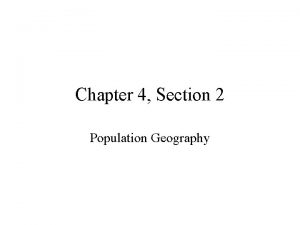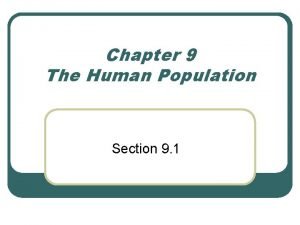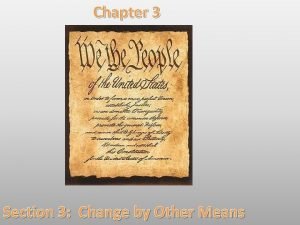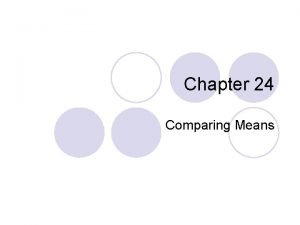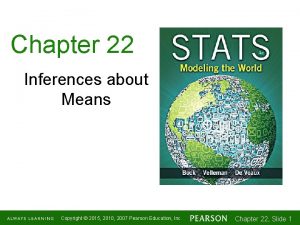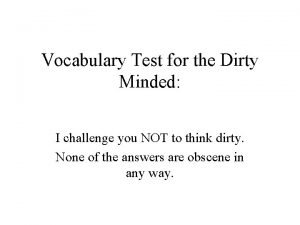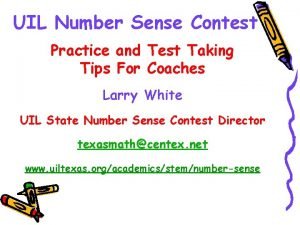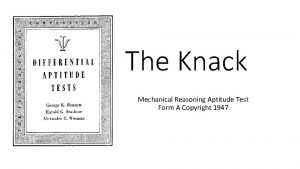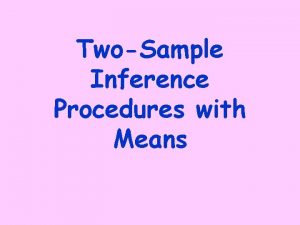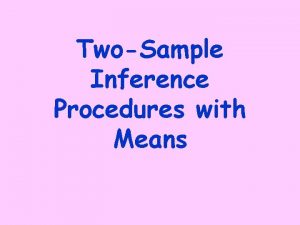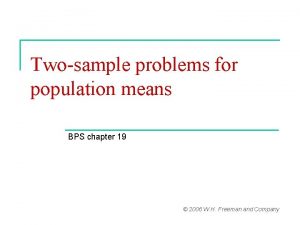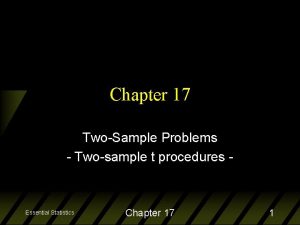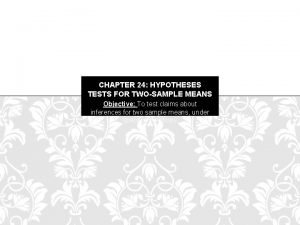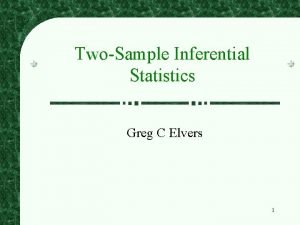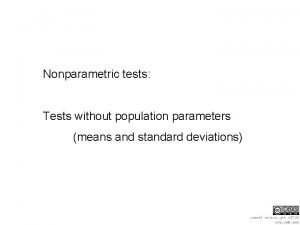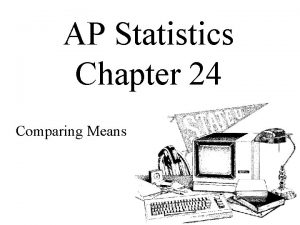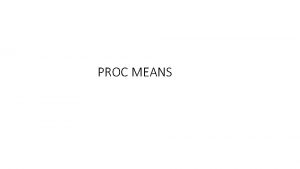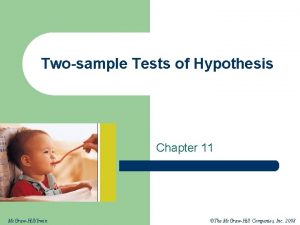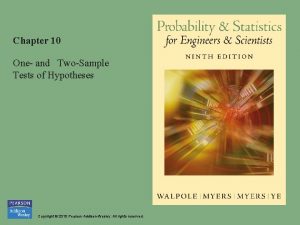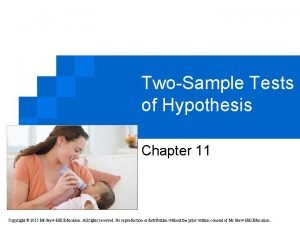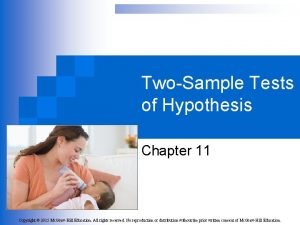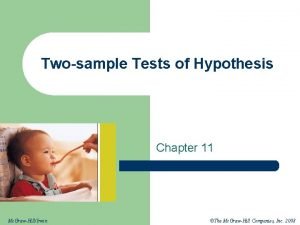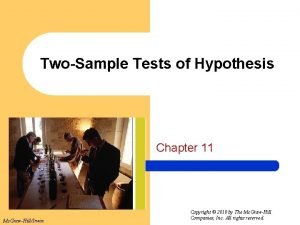Chapter 10 TwoSample Tests TwoSample Tests Population Means





































- Slides: 37

Chapter 10 Two-Sample Tests

Two-Sample Tests Population Means, Independent Samples Population Means, Related Samples Population Proportions Population Variances Examples: Group 1 vs. Group 2 Same group before vs. after treatment Proportion 1 vs. Proportion 2 Variance 1 vs. Variance 2

Difference Between Two Means: Independent Samples Population means, independent samples n * σ1 and σ2 unknown, assumed equal σ1 and σ2 unknown, not assumed equal Different data sources n n Unrelated Independent n Sample selected from one population has no effect on the sample selected from the other population Use Sp to estimate unknown σ. Use a Pooled-Variance t test. Use S 1 and S 2 to estimate unknown σ1 and σ2. Use a Separate-variance t test

Hypothesis tests for μ 1 – μ 2 Two Population Means, Independent Samples Lower-tail test: Upper-tail test: Two-tail test: H 0: μ 1 – μ 2 0 H 1: μ 1 – μ 2 < 0 H 0: μ 1 – μ 2 ≤ 0 H 1: μ 1 – μ 2 > 0 H 0: μ 1 – μ 2 = 0 H 1: μ 1 – μ 2 ≠ 0 -t Reject H 0 if t. STAT < -t t Reject H 0 if t. STAT > t /2 -t /2 Reject H 0 if t. STAT < -t /2 or t. STAT > t /2

Hypothesis tests for µ 1 - µ 2 with σ1 and σ2 unknown and assumed equal • The pooled variance is: Population means, independent samples σ1 and σ2 unknown, assumed equal σ1 and σ2 unknown, not assumed equal * • The test statistic is: • Where t. STAT has d. f. = (n 1 + n 2 – 2)

Pooled-Variance t Test Example You are a financial analyst for a brokerage firm. Is there a difference in dividend yield between stocks listed on the NYSE & NASDAQ? You collect the following data: NYSE NASDAQ Number 21 25 Sample mean 3. 27 2. 53 Sample std dev 1. 30 1. 16 Assuming both populations are approximately normal with equal variances, is there a difference in mean yield ( = 0. 05)?

Pooled-Variance t Test Example: Calculating the Test Statistic H 0: μ 1 - μ 2 = 0 i. e. (μ 1 = μ 2) H 1: μ 1 - μ 2 ≠ 0 i. e. (μ 1 ≠ μ 2) The test statistic is:

Pooled-Variance t Test Example: Hypothesis Test Solution H 0: μ 1 - μ 2 = 0 i. e. (μ 1 = μ 2) H 1: μ 1 - μ 2 ≠ 0 i. e. (μ 1 ≠ μ 2) = 0. 05 df = 21 + 25 - 2 = 44 Critical Values: t = ± 2. 0154 Test Statistic: Reject H 0 . 025 -2. 0154 Reject H 0 . 025 0 2. 0154 t 2. 040 Decision: Reject H 0 at = 0. 05 Conclusion: There is evidence of a difference in means.

Pooled Variance T-Test, page 350 n Open Two-Sample Tests Excel file on Oncourse n n n All sample calculations have been provided, excel functions are next to values In cell B 16 type B 7 -1 In cell B 17 type B 11 – 1 In cell B 18 type B 16 + B 17 In cell B 19 type = ((B 16 * B 9^2) + (B 17*B 13^2))/B 18 In cell B 20 type = Sqrt(B 19*(1/B 7 +1/B 11) In cell B 21 type = B 8 – B 12 In cell B 22 type = (B 21 – B 4)/B 20 In cell B 25 type = -tinv(B 5, B 18) In cell B 26 type = tinv(B 5, B 18) In cell B 27 type = TDIST(ABS(B 22), B 18, 2) In cell B 28 type = IF(B 27<B 5, “Reject the null hypothesis”, “Do not reject the null hypothesis”)

Hypothesis tests for µ 1 - µ 2 with σ1 and σ2 unknown and not assumed equal Population means, independent samples σ1 and σ2 unknown, assumed equal σ1 and σ2 unknown, not assumed equal The test statistic is: t. STAT has d. f. ν = *

Separate-Variance t Test Example You are a financial analyst for a brokerage firm. Is there a difference in dividend yield between stocks listed on the NYSE & NASDAQ? You collect the following data: NYSE NASDAQ Number 21 25 Sample mean 3. 27 2. 53 Sample std dev 1. 30 1. 16 Assuming both populations are approximately normal with unequal variances, is there a difference in mean yield ( = 0. 05)?

Separate-Variance t Test Example: Calculating the Test Statistic H 0: μ 1 - μ 2 = 0 i. e. (μ 1 = μ 2) H 1: μ 1 - μ 2 ≠ 0 i. e. (μ 1 ≠ μ 2) The test statistic is: Use degrees of freedom = 40

Separate-Variance t Test Example: Hypothesis Test Solution H 0: μ 1 - μ 2 = 0 i. e. (μ 1 = μ 2) H 1: μ 1 - μ 2 ≠ 0 i. e. (μ 1 ≠ μ 2) = 0. 05 df = 40 Critical Values: t = ± 2. 021 Test Statistic: Reject H 0 . 025 -2. 021 Reject H 0 . 025 0 2. 021 2. 019 t Decision: Fail To Reject H 0 at = 0. 05 Conclusion: There is insufficient evidence of a difference in means.

Unequal Variance (using same data as pooled variance), page 356 n n n n In cell B 16 type =B 9^2 In cell B 17 type =B 13^2 In cell B 18 type =B 16/B 7 In cell B 19 type =B 17/B 11 In cell B 20 type =(B 18+B 19)^2 In cell B 21 type =(B 18^2)/(B 7 -1)+(B 19^2)/(B 11 -1) In cell B 22 type = B 20/B 21 In cell B 23 type = INT(B 22) In cell B 24 type = =SQRT(B 18+B 19) In cell B 25 type = =B 8 -B 12 In cell B 26 type = =(B 25 -B 4)/B 24 In cell B 29 type = -tinv(B 5, B 23) In cell B 30 type = tinv(B 5, B 23) In cell B 31 type = TDIST(ABS(B 22), B 19, 2) In cell B 32 type = IF(B 27<B 5, “Reject the null hypothesis”, “Do not reject the null hypothesis”)

Related Populations The Paired Difference Tests Means of 2 Related Populations Related samples n n n Paired or matched samples Repeated measures (before/after) Use difference between paired values: Di = X 1 i - X 2 i n n Eliminates Variation Among Subjects Assumptions: n Both Populations Are Normally Distributed n Or, if not Normal, use large samples

Related Populations The Paired Difference Test The ith paired difference is Di , where Related samples Di = X 1 i - X 2 i The point estimate for the paired difference population mean μD is D : The sample standard deviation is SD n is the number of pairs in the paired sample

The Paired Difference Test: Finding t. STAT Paired samples n The test statistic for μD is: n Where t. STAT has n - 1 d. f.

The Paired Difference Test: Possible Hypotheses Paired Samples Lower-tail test: Upper-tail test: Two-tail test: H 0: μ D 0 H 1: μ D < 0 H 0: μ D ≤ 0 H 1: μ D > 0 H 0: μ D = 0 H 1: μ D ≠ 0 -t Reject H 0 if t. STAT < -t t Reject H 0 if t. STAT > t Where t. STAT has n - 1 d. f. /2 -t /2 Reject H 0 if t. STAT < -t /2 or t. STAT > t /2

Paired Difference Test: Example Assume you send your salespeople to a “customer service” training workshop. Has the training made a difference in the number of complaints? You collect the following data: n Number of Complaints: (2) - (1) Salesperson Before (1) After (2) Difference, Di C. B. T. F. M. H. R. K. M. O. 6 20 3 0 4 4 6 2 0 0 - 2 -14 - 1 0 - 4 -21 D = Di n = -4. 2

Paired Difference Test: Solution n Has the training made a difference in the number of complaints (at the 0. 01 level)? H 0: μ D = 0 H 1: μD 0 =. 01 D = - 4. 2 t 0. 005 = ± 4. 604 d. f. = n - 1 = 4 Test Statistic: Reject /2 - 4. 604 - 1. 66 4. 604 Decision: Do not reject H 0 (tstat is not in the reject region) Conclusion: There is not a significant change in the number of complaints.

Paired T-Test (Mean and Standard Deviation), page 361 n n In Cell E 2 type = C 2 – D 2, drag through E 17 In Cell F 2 type = (E 2 - $B$22)^2, draft through F 17

Paired T-Test (Calculations), page 361 n n n n n In cell B 8 type your n-value (16) In cell B 9 type = AVERAGE('Paired t Test (Mean & St Dev)'!E 2: E 17) In cell B 10 type = B 8 -1 In Cell B 11, type = SQRT(SUM('Paired t Test (Mean & St Dev)'!F 2: F 17)/('Paired t Test (Calculations)'!B 8 -1)) In cell B 12 type = B 11/sqrt(B 8) In cell B 13 type = (B 9 – B 4)/B 12 In cell B 16 type = -tinv(B 5, B 10) In cell B 17 type = tinv(B 5, B 10) In cell B 18 type = TDIST(ABS(B 13), B 10, 2) In cell B 19 type = IF(B 18<B 5, “Reject the null hypothesis”, “Do not reject the null hypothesis”)

Two Population Proportions Population proportions Goal: test a hypothesis or form a confidence interval for the difference between two population proportions, π1 – π2 Assumptions: n 1 π1 5 , n 1(1 - π1) 5 n 2 π2 5 , n 2(1 - π2) 5 The point estimate for the difference is

Two Population Proportions Population proportions In the null hypothesis we assume the null hypothesis is true, so we assume π1 = π2 and pool the two sample estimates The pooled estimate for the overall proportion is: where X 1 and X 2 are the number of items of interest in samples 1 and 2

Two Population Proportions The test statistic for π1 – π2 is a Z statistic: Population proportions where

Hypothesis Tests for Two Population Proportions Population proportions Lower-tail test: Upper-tail test: Two-tail test: H 0: π 1 – π 2 0 H 1: π 1 – π 2 < 0 H 0: π 1 – π 2 ≤ 0 H 1: π 1 – π 2 > 0 H 0: π 1 – π 2 = 0 H 1: π 1 – π 2 ≠ 0 -z Reject H 0 if ZSTAT < -Z z Reject H 0 if ZSTAT > Z /2 -z /2 Reject H 0 if ZSTAT < -Z /2 or ZSTAT > Z /2

Hypothesis Test Example: Two population Proportions Is there a significant difference between the proportion of men and the proportion of women who will vote Yes on Proposition A? n n In a random sample, 36 of 72 men and 35 of 50 women indicated they would vote Yes Test at the. 05 level of significance

Hypothesis Test Example: Two population Proportions n The hypothesis test is: H 0: π1 – π2 = 0 (the two proportions are equal) H 1: π1 – π2 ≠ 0 (there is a significant difference between proportions) n The sample proportions are: n Men: p 1 = 36/72 = 0. 50 n Women: p 2 = 35/50 = 0. 70 § The pooled estimate for the overall proportion is:

Hypothesis Test Example: Two population Proportions The test statistic for π1 – π2 is: Reject H 0 . 025 -1. 96 -2. 20 1. 96 Decision: Reject H 0 Critical Values = ± 1. 96 For =. 05 Conclusion: There is significant evidence of a difference in the proportion of men and women who will vote yes.

Z-Test for Two Proportions, page 370 n n n n n In cell B 14 type = B 7/B 8 In cell B 15 type = B 10/B 11 In cell B 16 type = B 14 – B 15 In cell B 17 type = (B 7 + B 10)/(B 8 + B 11) In cell B 18 type = (B 16 – B 4)/sqrt(B 7*(1 -B 7)*(1/B 8 + 1/B 11)) In cell B 21 type = normsinv(B 5/2) In cell B 22 type = normsinv(1 -B 5/2) In cell B 23 type = 2*(1 – normsdist(ABS(B 18))) In cell B 24 type = IF(B 23<B 5, “Reject the null hypothesis”, “Do not reject the null hypothesis”)

Testing for the Ratio Of Two Population Variances Tests for Two Population Variances F test statistic * Hypotheses H 0: σ 12 = σ 22 H 1: σ 12 ≠ σ 22 H 0: σ 12 ≤ σ 22 H 1: σ 12 > σ 22 FSTAT S 12 / S 22 Where: S 12 = Variance of sample 1 (the larger sample variance) n 1 = sample size of sample 1 S 22 = Variance of sample 2 (the smaller sample variance) n 2 = sample size of sample 2 n 1 – 1 = numerator degrees of freedom n 2 – 1 = denominator degrees of freedom

The F Distribution n n The F critical value is found from the F table There are two degrees of freedom required: numerator and denominator n The larger sample variance is always the numerator n When n In the F table, df 1 = n 1 – 1 ; df 2 = n 2 – 1 n numerator degrees of freedom determine the column n denominator degrees of freedom determine the row

Finding the Rejection Region H 0: σ 12 = σ 22 H 1: σ 12 ≠ σ 22 H 0: σ 12 ≤ σ 22 H 1: σ 12 > σ 22 /2 0 Do not reject H 0 Fα/2 Reject H 0 if FSTAT > Fα/2 F 0 Do not reject H 0 Fα Reject H 0 if FSTAT > Fα F

F Test: An Example You are a financial analyst for a brokerage firm. You want to compare dividend yields between stocks listed on the NYSE & NASDAQ. You collect the following data: NYSE NASDAQ Number 21 25 Mean 3. 27 2. 53 Std dev 1. 30 1. 16 Is there a difference in the NYSE 0. 05 level? variances between & NASDAQ at the =

F Test: Example Solution n DCOVA Form the hypothesis test: H 0: σ21 = σ22 (there is no difference between variances) H 1: σ21 ≠ σ22 (there is a difference between variances) n Find the F critical value for = 0. 05: n Numerator d. f. = n 1 – 1 = 21 – 1 =20 n Denominator d. f. = n 2 – 1 = 25 – 1 = 24 n Fα/2 = F. 025, 20, 24 = 2. 33

F Test: Example Solution DCOVA (continued) n The test statistic is: H 0 : σ1 2 = σ2 2 H 1 : σ1 2 ≠ σ2 2 /2 =. 025 0 n n FSTAT = 1. 256 is not in the rejection region, so we do not reject H 0 Do not reject H 0 Conclusion: There is not sufficient evidence of a difference in variances at =. 05 Reject H 0 F 0. 025=2. 33 F

F Test for Ratio of Two Variances (using same data as pooled variance), page 376 n n n In cell B 13 type = B 7/B 10 In cell B 14 type = B 6 -1 In cell B 15 type = B 9 - 1 In cell B 18 type = FINV(B 4/2, B 14, B 15) In cell B 19 type = 2*FDIST(B 13, B 14, B 15) In cell B 20 type = IF(B 19<B 4, “Reject the null hypothesis”, “Do not reject the null hypothesis”)
 Population ecology section 1 population dynamics answer key
Population ecology section 1 population dynamics answer key Chapter 4 section 1 population dynamics study guide
Chapter 4 section 1 population dynamics study guide Ace different tests help iq still
Ace different tests help iq still Population ecology section 1 population dynamics
Population ecology section 1 population dynamics Population ecology section 1 population dynamics
Population ecology section 1 population dynamics Population growth means
Population growth means Quadrilateral pentagon hexagon octagon
Quadrilateral pentagon hexagon octagon Meta means and morphe means
Meta means and morphe means Meta and morph means
Meta and morph means Biodiversity conservation definition
Biodiversity conservation definition Life bio
Life bio Chapter 23 specimen collection and diagnostic testing
Chapter 23 specimen collection and diagnostic testing Chapter 20 more about tests and intervals
Chapter 20 more about tests and intervals Chapter 24 diagnostic tests and specimen collection
Chapter 24 diagnostic tests and specimen collection Chapter 4 section 1 population dynamics
Chapter 4 section 1 population dynamics Chapter 53 population ecology
Chapter 53 population ecology Chapter 4 section 2 human population
Chapter 4 section 2 human population Chapter 4 section 1 population dynamics answer key
Chapter 4 section 1 population dynamics answer key Chapter 36 population ecology
Chapter 36 population ecology Chapter 4 population ecology answer key
Chapter 4 population ecology answer key Chapter 53 population ecology
Chapter 53 population ecology Chapter 4 section 2 population geography
Chapter 4 section 2 population geography Chapter 2 population and health key issue 3
Chapter 2 population and health key issue 3 Chapter 53 population ecology
Chapter 53 population ecology Chapter 9 the human population section 1
Chapter 9 the human population section 1 Chapter 3 section 3 change by other means
Chapter 3 section 3 change by other means Chapter 24 comparing means
Chapter 24 comparing means Chapter 22 inferences about means
Chapter 22 inferences about means Resting pulse rates for a random sample of 26
Resting pulse rates for a random sample of 26 Year 4 mental maths test
Year 4 mental maths test Apes lab
Apes lab Romberga tests
Romberga tests Dirty minded words
Dirty minded words Number sense practice
Number sense practice Uil calculator practice tests
Uil calculator practice tests Mechanical reasoning test
Mechanical reasoning test Shrek meeting the mentor
Shrek meeting the mentor Univariate analysis tests
Univariate analysis tests





